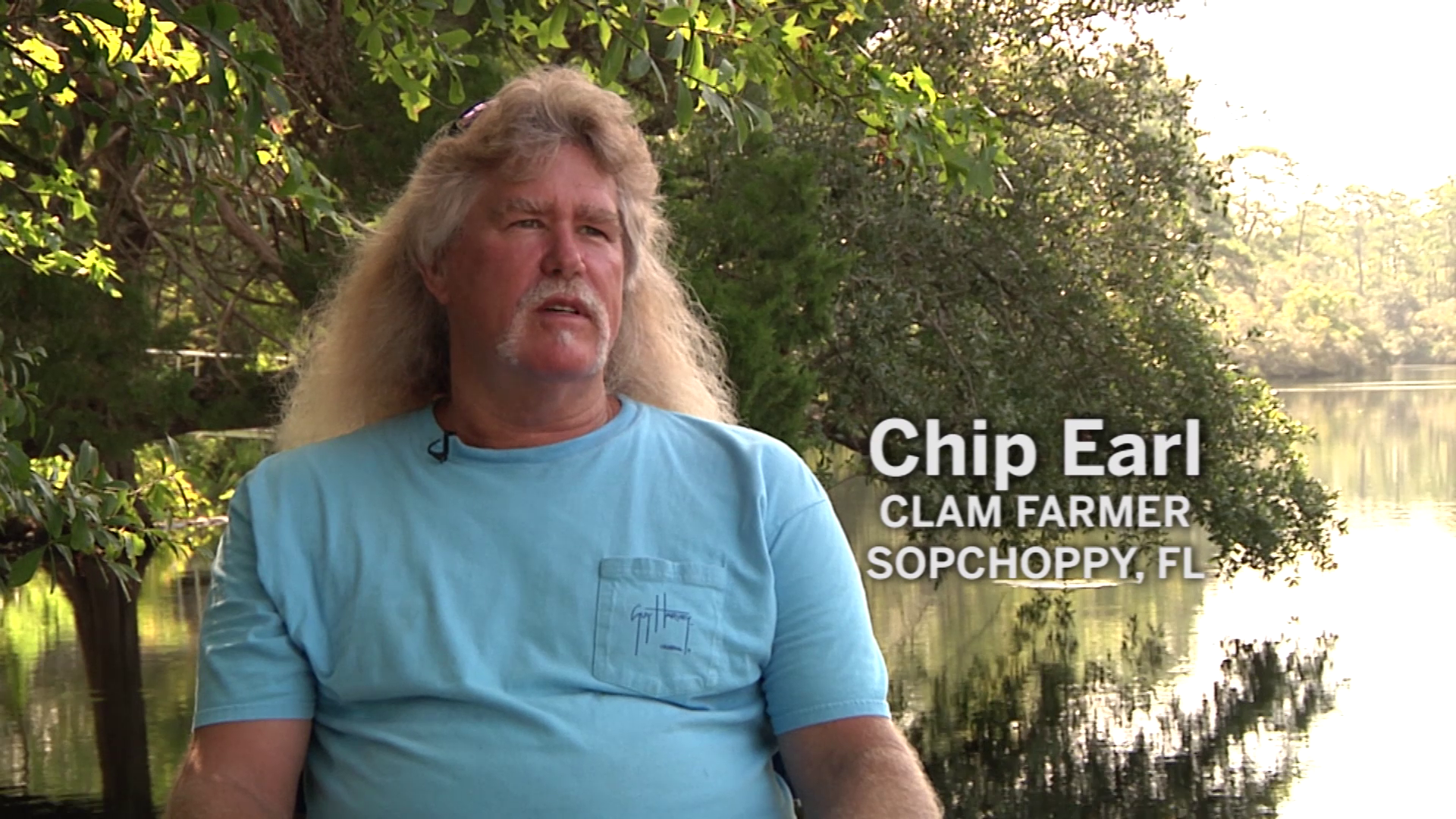

WFSU’s Mike Plummer tapped into his own curiosity and headed south to Alligator Harbor to find out about clam farming. If you look out over the waters of Alligator Harbor, you will see a proliferation of white PVC pipes jutting from the surface. Mike wondered what those white tubes were and asked around. He finally got an answer – clam leases. They farm clams out there. Mike decided he wanted to meet a clam farmer and that is how he met Chip Earl and his wife Carol.
Chip explained the white tubes. “Okay, basically, each lease is 80 feet by 800 feet, which is roughly an acre and a half.” The tubes mark the boundaries of each lease. “What we’re growing is Northern clams. These clams grow from here up to Maine and it’s basically a northern variety that grown heavily along the eastern seaboard. The Southern clam that we have native here doesn’t do well under refrigeration, so that’s why we don’t use that clam.” He shows a mesh bag with a tight weave and clam seed on his fingers for comparison. “When we get the clam seed, it’s four millimeters in size, which is just a little bigger than the holes that are in these bags. And when we plant these, we put roughly 8,000 to a bag. But they’re only going to be down there 6 to 8 weeks, so in that span of time they’ll usually be about dime to nickel size. And then you remove those and transfer them into larger mesh bags, which are called your grow-out bags. That takes about three, four weeks of going every day. To get it all transferred you’re typically doing about 500 bags at a time. So it takes a little bit of work to get that all done. And those typically stay down there for 15 to 18 months.”
At the time Mike was visiting with Chip and Carol Earl, it was harvesting time and Chip was filling the weekly order for his clams. He walks through his lease, loosening the corners of the bags so he can pull them up to be hooked onto ropes. There’s very little visibility, so much of this work is done by feel.
The purpose of the grow-out bags are to keep predators from the clams – primarily stingrays, crabs and drumfish. It’s not a fool-proof method. Each grow-out bag starts with about a thousand clams. Over time, the clams burrow into the sand bottom, bag and all, which makes the harvest a very physical task.
Chip stands in chest deep water wearing gloves and holding a rake to pull up the edges of the bags. “So we always time it to where your head’s at least out of the water. Otherwise then you’ got to do it with a diving rig and it’s a lot more strenuous to do that. So right here I’ve got clams that are younger, and then I’m gonna be going back there where it’s the older clams that we’re gonna be pulling. The way I do it, I plant in long batches from shallow out to deep so no matter what the tide’s doing, I’ve always got somewhere where I can get to it so you’re not having to use a dive rig to go underwater.” In the wintertime, there are very low tides which don’t allow the boat to get to the shallower areas. Having them spread out from shallow to deep means that no matter what the tides are doing, there is always an area that can be harvested without using a dive rig to go underwater.
Harvesting the clams isn’t the end of the job. Chip and Carol take their clams to the St. Teresa Clam Company for refrigeration and processing. The first step is culling the waste – big shells that are already opened and dead. There is a good number of those, but Chip isn’t overly concerned. “They’re not all gonna survive. That’s what the crabs do, you can see the shells. They wait ‘til the clam opens up and then they stick their claw in there and then bust ‘em.”
Chip says he expects to average about a 30% loss from planting to harvest. After separating the good, live clams from the junk, the final step is sorting the clams by size – little neck, middle neck, top neck and cherry stone, with little neck being the smallest and cherry stone the largest. The sorter separates the sizes into mesh bags color-coded for size and each one holds 200 clams.
Self-motivation is key to being a successful clam farmer. Everything needs to happen when it needs to happen and taking a day or two off because you don’t feel like it can snowball.
“You can’t let it get backed up on you because there’s certain stages of the process you have to have things ready and in place to go. If you don’t then you’re gonna have losses,” says Chip.
Mike Plummer is a content producer and editor for television at WFSU Public Media. He spent 25 years in commercial television as an art director, commercial director, promotion manager, station manager and creative services director before coming to WFSU in 2008. Mike likes to find the “unusual” or “out of the ordinary” stories in our Local Routes. He says the best part of his job is getting to know people he would otherwise probably not get a chance to meet. Mike is widowed, has a rescue dog named Dexter, and is constantly at war with the vines growing in his backyard.





